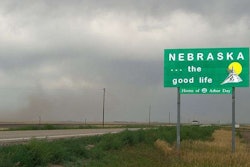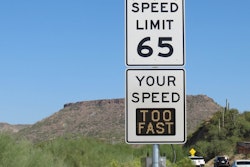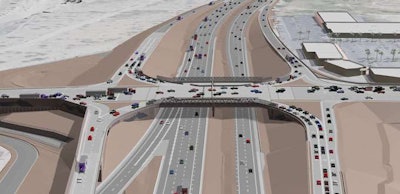 An artist’s rendering of a $40 million project on Interstate 19 at Ajo Way in West Tucson, Ariz. Construction is wrapping up for the first of two projects at the interchange.
An artist’s rendering of a $40 million project on Interstate 19 at Ajo Way in West Tucson, Ariz. Construction is wrapping up for the first of two projects at the interchange.
A $40 million, two-year project to rebuild the traffic interchange at Interstate 19 and Ajo Way (State Route 86) is nearing completion in southwest Tucson, Arizona, and it features a new configuration designed for efficiency and safety.
A second project for the busy interchange will be let out for contractors’ bids in Spring 2018.
The new interchange will feature a widened Ajo Way bridge over I-19 and a single set of traffic signals controlling traffic entering and exiting the interstate, rather than signals at multiple locations.
“We have an opportunity at Ajo Way and I-19 to use a design that allows traffic to move more efficiently through the intersection more quickly because drivers only have to move through one set of lights instead of two,” says James Gomes, regional traffic engineer for ADOT’s South Central District.
Single-point urban interchange improves flow, safety
Created in 1974 in Clearwater, Florida, the design is called a single-point urban interchange. With this configuration, left-turn drivers from opposite directions can move through the intersection at the same time.
The design accommodates larger vehicles, including trucks and recreational vehicles, better than traditional diamond interchanges can, ADOT says. And while the rate of collisions is about the same with this as with diamond interchanges, the single-point urban interchange has a lower rate of injuries and fatalities, the department says.
The new signals are to begin operating in January. For now, temporary signals are in place.
I-19 and Ajo Way will be ADOT’s third single-point urban interchange in the Tucson area. Others are at I-19 and Valencia Road, and at Kino Parkway and State Route 210 (Barraza-Aviation Parkway).
Arizona DOT, along with the Federal Highway Administration, began the two-part project in March 2016 to improve traffic efficiency and public safety in this growing area about five miles southwest of downtown Tucson.
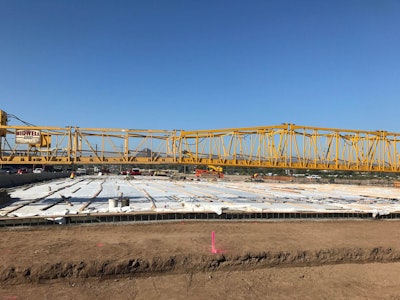 On Interstate 19 in Tucson, the Ajo Way (State Route 86) bridge deck pour. After crews poured the new bridge deck in mid December, the first phase of the project, which also includes widening Ajo Way and improved exit ramps at Ajo Way and Irvington Road, remains on schedule for completion in the spring.
On Interstate 19 in Tucson, the Ajo Way (State Route 86) bridge deck pour. After crews poured the new bridge deck in mid December, the first phase of the project, which also includes widening Ajo Way and improved exit ramps at Ajo Way and Irvington Road, remains on schedule for completion in the spring.
The first phase, called project one, will include replacement of the existing traffic interchange with the single-point interchange over I-19.
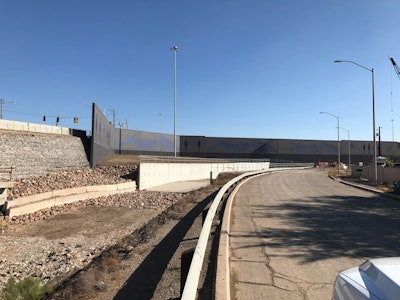
Among other elements of the first phase:
- Widening 500 feet of the southbound Irvington Road off-ramp to provide an additional turn lane and increased capacity to prevent traffic from backing up on the interstate
- Widening Ajo Way east of I-19 and upgrading the traffic signal at 16th Avenue
- Constructing noise walls along both sides of I-19 between Ajo Way and the Michigan Avenue pedestrian bridge to the south
Work on the first phase is expected to be complete in March or April 2018, according to Tom Herrmann, a spokesman for ADOT.
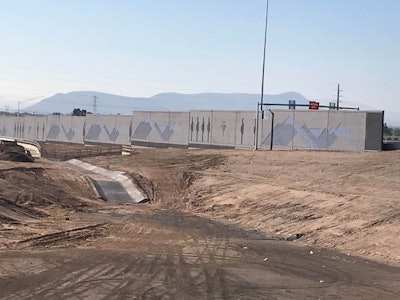 I-19 noise walls south of Michigan Avenue and along the south side of Ajo Way between Kostka Avenue and I-19.
I-19 noise walls south of Michigan Avenue and along the south side of Ajo Way between Kostka Avenue and I-19.Phase 2 begins in Spring 2018
Once the first phase is completed, the bidding process will begin for the second phase. It will include widening southbound I-19, an additional transition lane for northbound traffic between Irvington and Ajo Way, and other improvements on Ajo Way .
Some of the improvements:
- Construction of a “braided” ramp alignment with the southbound Ajo Way on-ramp to I-19 passing overtop the southbound Irvington off-ramp from I-19
- Completion of I-19 noise walls south of Michigan Avenue and along the south side of Ajo Way from Kostka Avenue to I-19
- Replacement of the Santa Cruz River Bridge on Ajo Way, west of I-19.
For more information on the project, click here.
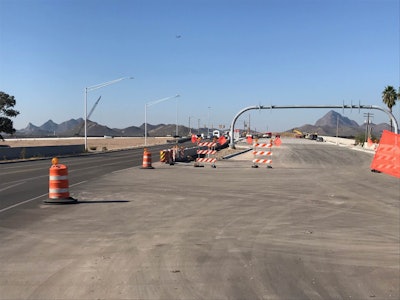 Bridge decks, old and new in the project to improve I-19 at Ajo Way in southwest Tucson, Arizona. The Federal Highway Administration began the two-part project in March 2016, saying it will improve traffic efficiency and public safety. Photos courtesy of ADOT.
Bridge decks, old and new in the project to improve I-19 at Ajo Way in southwest Tucson, Arizona. The Federal Highway Administration began the two-part project in March 2016, saying it will improve traffic efficiency and public safety. Photos courtesy of ADOT.





